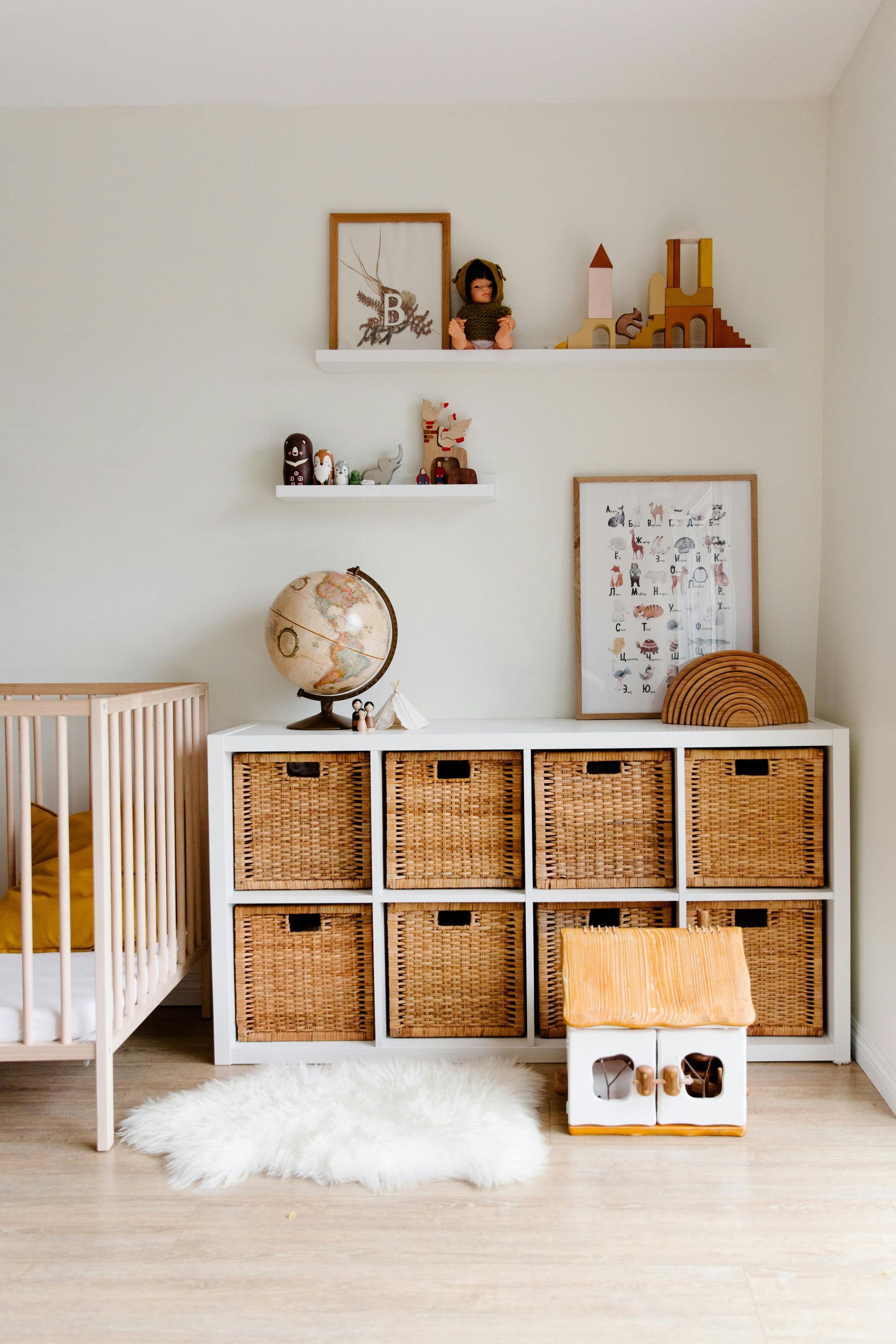7 Ways to Design a
Calming Kid's Bedroom
Share

7 min read
By Justine Murray
How to Create a Soothing Bedroom
That Helps Kids Sleep Better
Parents often underestimate just how much a child’s bedroom environment affects their ability to relax and sleep well. A bright, noisy, cluttered space filled with distractions can overstimulate children and make bedtime battles even harder. On the other hand, a carefully designed, calming environment can become a safe haven where your child feels secure, nurtured, and ready to rest.
Designers and sleep experts alike agree: your child’s bedroom should not just be a place to sleep, but a space that supports their mental health, encourages relaxation, and gently eases them into restorative sleep.
In this guide, we’ll explore the key elements of a sleep-friendly children’s bedroom — from lighting and acoustics to color psychology, natural elements, cozy textures, and furniture layout.
Why the Bedroom Environment Matters for Sleep
Children are highly sensitive to sensory input — light, color, sound, and clutter can all influence whether they feel calm or restless. Research shows that overstimulating environments can increase anxiety and disrupt healthy sleep cycles. For children, whose developing brains need more rest than adults, setting the right environment can make the difference between peaceful nights and ongoing struggles.
According to interior designer Carolyn Feder, “A child’s bedroom should be a haven, a space they love spending time in, where they feel safe as they drift off to sleep.” In a fast-paced world filled with overstimulation, the bedroom is where children’s minds, bodies, and emotions recalibrate.
Lighting: The Foundation of a Calm Room
The key is to create a clean, simple environment that invites relaxation, not distraction.
Furniture Layout: Designing Zones for Balance
Interior designers recommend thinking of a child’s bedroom in functional “zones.” Carolyn Feder uses the acronym
SPEL
- Sleep, Play, Enjoy, Learn. Each room should cater to these, with sleep taking priority.
- Bed placement: Position the bed away from windows and doors to create a sense of security.
- Study zone: If a desk is needed, separate it visually from the sleep area to avoid mixing “work” and “rest.”
- Play zone: Keep toys and play items organised in one section, not scattered across the room.
Lighting is often the most overlooked element of bedroom design, yet it has the greatest impact on sleep quality.
- Daytime light: Encourage natural light during the day to support mood and circadian rhythms.
- Evening light: At night, lighting should be warm and subdued. Bright white or fluorescent bulbs are harsh and can mimic daylight, preventing melatonin release. Instead, choose full-spectrum bulbs with dimmer switches.
- Layered lighting: Use lamps with multiple settings so light can be gradually lowered as bedtime approaches.
- Window treatments: Invest in light-filtering blinds or blackout curtains, depending on your child’s sensitivity. Always choose cordless options for safety.
Lighting should support a natural transition from wakefulness to sleep — bright and energising in the morning, soft and calming at night.
Acoustics: Quieting the Noise
Sound plays an equally important role in creating a relaxing environment. Bedrooms with hard surfaces, like tiles or plastic blinds, can amplify noise and feel cold. Instead, choose softer, sound-absorbing materials:
- Flooring: Wood floors with rugs are better than tiles or laminate.
- Window coverings: Fabric blinds or drapes help buffer outside noise.
- Insulation: Where possible, ensure walls are insulated to minimise external disturbances.
For children who are sensitive to sound, a white noise machine can help drown out disruptions and create a steady, comforting soundscape.
Color Psychology: Choosing Sleep-Friendly Shades
Color affects mood. While bold reds and bright patterns may appeal to a child’s imagination, they are too stimulating for a sleep environment. Instead, focus on calming shades:
- Best choices: Soft neutrals (gray, taupe, cream) paired with pastels like lavender, sage, or pale blue.
- Avoid: High-contrast schemes, dark reds, or neon accents.
- Walls vs. accessories: Keep walls and large surfaces neutral, while adding small pops of color through accessories, art, or cushions.
The goal is to create a gentle, soothing palette that feels safe and restful.
Bringing Nature Indoors
Nature has a calming effect on children and adults alike. Incorporating natural elements into a bedroom can send subliminal messages of peace and stability:
- Wall art: Choose photographic images of landscapes, forests, or oceans rather than abstract art. Photos help children connect with real-world details.
- Textures: Use wood, rattan, or bamboo in furniture and decor for warmth.
- Plants: Low-maintenance plants can improve air quality and introduce greenery, but ensure they are safe for children.
Nature-inspired design not only soothes but also encourages mindfulness and observation.
Cozy Comfort: Textures That Nurture
Children crave comfort and often self-soothe by cuddling into soft, safe objects. A well-designed bedroom should include:
- Soft bedding: Test fabrics for softness and durability. Choose breathable cotton or linen for comfort.
- Weighted blankets or body pillows: These provide a gentle “hug” effect, reducing anxiety.
- Family photos: Displaying photos of loved ones helps children feel secure.
- Tactile items: Plush rugs, cushions, or a favorite stuffed toy add comfort and familiarity.
Encouraging coziness helps children view their bedroom as a safe retreat.
Decluttering and Limiting Stimulation
Clutter is a major source of stress and overstimulation. Even with the lights off, a chaotic environment can disrupt a child’s sleep.
- Storage solutions: Use baskets, bins, and cupboards to hide toys and supplies.
- Screen-free zone: Enforce a no-screens rule in the bedroom to avoid blue-light interference.
- Minimal decor: Avoid overloading walls with posters or busy patterns. A simplified space fosters calmness.
How furniture is arranged can dramatically impact how a child perceives and uses their space.
The Bigger Picture: Why It Matters
A soothing bedroom does more than improve sleep. It helps children regulate their emotions, manage stress, and develop healthy routines. In a world of constant stimulation — from devices to busy schedules — having one space designed solely for rest and security is vital for mental and physical well-being.
Good sleep contributes to better behaviour, stronger immune systems, and improved concentration at school. By prioritising the bedroom environment, parents give children a lifelong gift: the ability to rest well and recharge.
Final Thoughts
Helping your child sleep better starts with creating the right environment. Through mindful choices in lighting, sound, color, nature, and organisation, parents can transform bedrooms into true havens. These are not cosmetic changes; they are investments in children’s health, happiness, and development.
Every element, from blackout curtains to cozy blankets, sends a message: this space is safe, calm, and made just for them. And when children feel that sense of security, good sleep naturally follows.
READ MORE

















